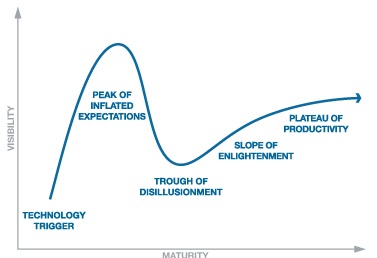We all know about the downsides of bubbles — the investment of time and money in hopeless projects, the over-inflated expectations, the fact that hype is all you see everywhere you go.
But whether you call a bubble, a boom, or, per the Gartner hype cycle, the “peak of inflated expectations,” hype isn’t all bad.
Here are a few reasons why.
1. Attracts investors
Getting an investor to put money into something brand new and unique is difficult.
The more unusual the project, the more data the investor will want to see. Market research studies, pilot projects, growth projections, competitive research, focus groups.

All this research is expensive and, if the technology is new enough, can be almost impossible to perform. Meanwhile, because the risks of the technology are so high, the investors will want to get a premium for their investment. That includes a bigger chunk of the company, board seats, lower valuations, and shorter-term exist strategies.
Bubbles create a “social proof” effect for investors that makes them more likely to throw money at speculative projects.
2. Educates the public about the technology
One of the downsides of technology bubbles is that you can’t get away from news about the new platform. Every magazine you open, every TV show you watch, the technology is all over the place.
This is annoying. But it also servers an important educational purpose. Even people who don’t want the technology, and who never plan to use the technology, are forced to learn about it.
If the technology is a major platform, like the Internet, like mobile devices and, now, virtual reality, then this is important. Because even if an individual people doesn’t plan to use it, their customers will, their competitors will, their friends and family members will use it.
3. Attracts new people to the field
When young people consider what fields to go into, they typically look at where the jobs are. Without hype, there wouldn’t be much reason to go into emerging areas that don’t have any jobs in them — yet.
Hype creates excitement about new careers that is disproportional to the number of jobs currently available, encouraging young people to go into those fields, allowing those fields to grow.
And it’s not just young people, either — older people will hear about the technology, and go out and get additional education so that they’re prepared for the future, as well.

4. Helps overcome fear of new technology
Most people are not early adopters. They’re wary of new technology until they’ve seen the technology well tested, proved out, and demonstrably useful.
New technology also brings with it additional risks. Risks of buying into a platform that doesn’t go anywhere. Risk of disappointment. Risk of not being able to learn how to use it and looking foolish.
The hype helps motivate people to try out new technologies and overcome those fears.

5. Attracts global attention
In the old days, it would take months — or years — before major inventions made their way to other countries.
Today, major technological developments rarely stay local. This means that innovations can come from any corner of the globe. With more perspectives, problems are solved quicker, promising startups are funded quicker, and customers are found quicker.

6. The money spent on bubbles doesn’t actually disappear
The millions of dollars that venture capitalists invest in startups comes from rich people who have money to spare and goes to pay salaries of creative, innovative, risk-taking people.
It’s common to say that a particular startup “is burning through cash,” but that cash isn’t actually being burned — it’s going back into the economy.

7. Helps build infrastructure for future growth
Rational people will wait to build infrastructure until it’s needed.
And technology companies will wait to roll out their technology until the infrastructure is in place.
Hype cycles encourage the early development of infrastructure, before all the technology applications are in place, allowing for faster deployment.
8. You never know which approach is going to work
Some people call it “irrational exuberance” and overinvestment in projects that never should have been funded.
Of course, it’s easy to tell in retrospect which projects are worthwhile and which ones aren’t.
But plenty of successful projects probably looked like long shots at the time, and might not have been funded at all except for the hype.

9. Even failed projects can be useful
Failed projects provide plenty of information. Specifically, about what doesn’t work. It saves other companies from making the same mistakes.
Plus, the experience gained, even from failed projects, is useful to individuals, who can then take their hard-won knowledge to their next jobs.
Failure — whether your own, or somebody else’s — is a great teacher.
10. Accelerates development
A bubble allows many different inventions, business plans and monetization strategies to be tried out all at once. instead of one at a time.
During the bubble, when the technology platform is still relatively new, many if not most of these attempts are bound to fail.
The faster these startups get funded, built, scaled out, and tested in the marketplace, the sooner we can tell what’s going to work and what isn’t.

Yes, that first wave of failures is painful — Gartner calls it the “trough of disillusionment” — but it gets us to the “slope of enlightenment” and the “plateau of productivity.”
- OSgrid back online after extended maintenance - April 16, 2025
- Analysts predict drop in headset sales this year - March 25, 2025
- OSgrid enters immediate long-term maintenance - March 5, 2025
